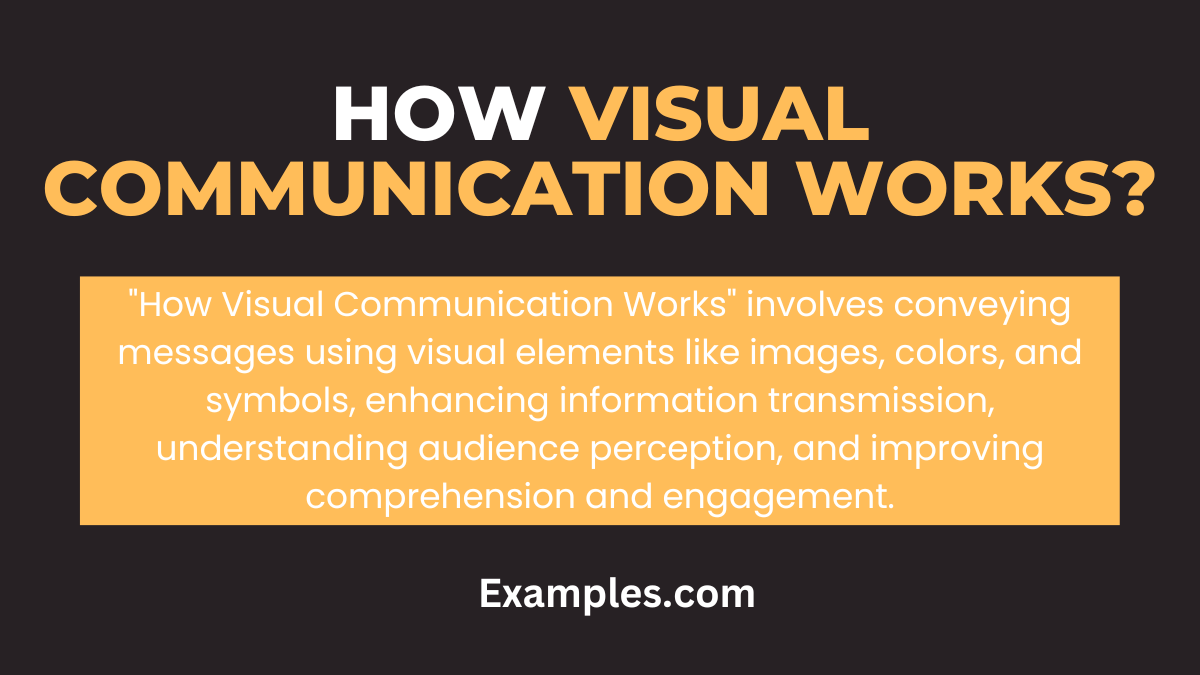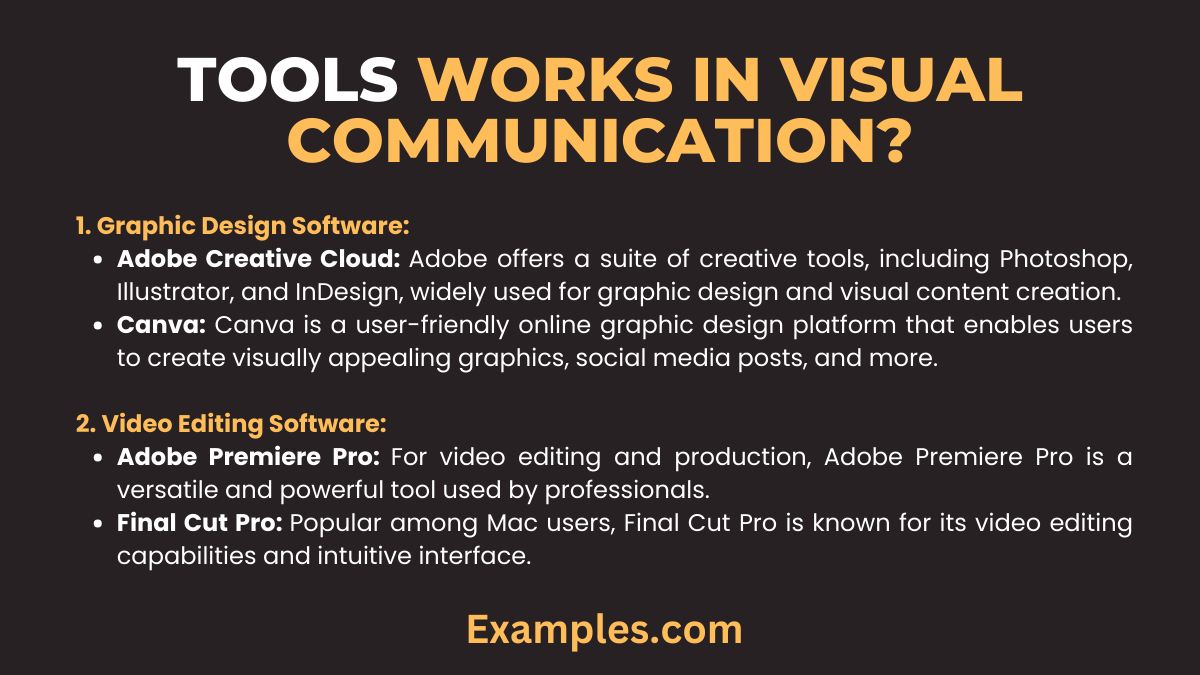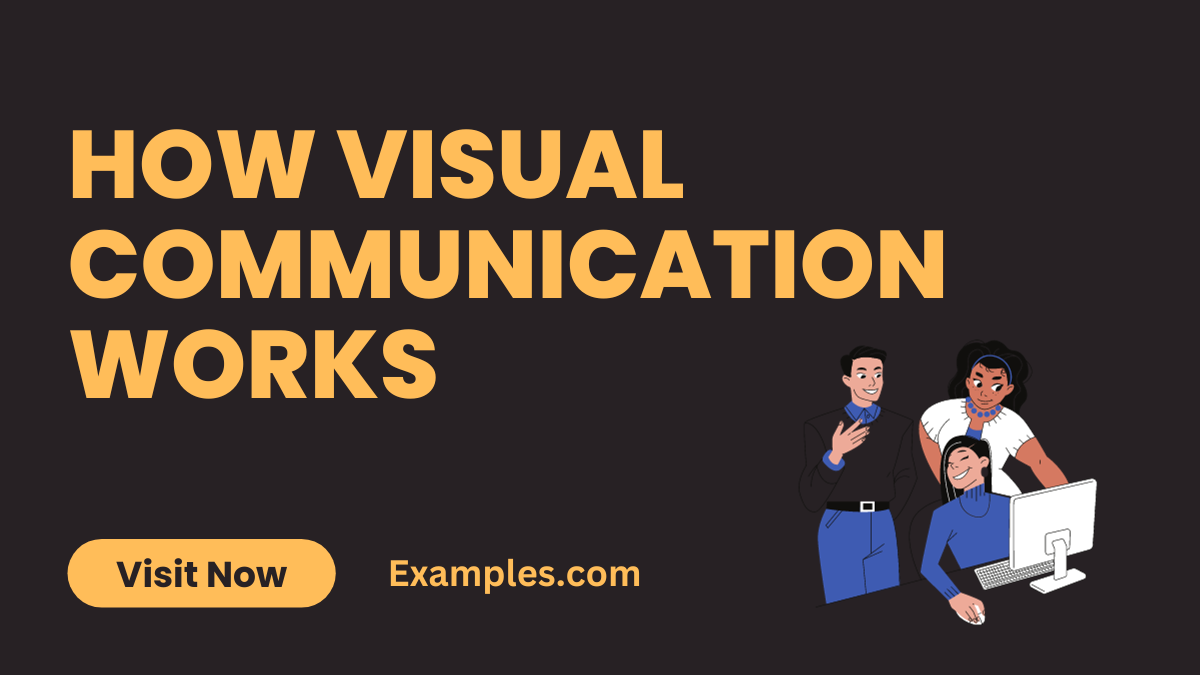How Visual Communication Works – 19+ Examples
“Visual communication” is an art and science, vital in conveying messages effectively. This comprehensive guide demystifies how visual communication operates, integrating rich Communication Examples to illustrate its principles. It delves into the use of images, symbols, colors, and designs, explaining how these elements combine to form clear, impactful messages. From marketing to education, understanding how visual communication works is crucial for crafting messages that resonate and achieve their intended impact in any field.
Download How Visual Communication Works PDF
How Visual Communication Works?

“How Visual Communication Works” refers to the process of conveying information and ideas through visual elements such as images, symbols, colors, and designs. This method of communication leverages the ability of visual cues to transmit messages more effectively and quickly than words alone. It includes understanding how these visual elements are perceived and interpreted by the audience, and how they can be strategically used to enhance comprehension, engagement, and retention of information in various contexts.
20 How Visual Communication Works Examples

Visual communication is a dynamic and vital medium for conveying information effectively. In this article, we explore compelling examples of how visual communication works, shedding light on its diverse applications.
- Infographics: Visual Communication Examples like infographics simplify complex data by combining visuals and text for easy comprehension.
- Charts and Graphs: These types of Visual Communication tools provide visual data representations for clearer insights.
- Logos: Visual communication skills include creating logos that symbolize a brand’s identity.
- Icons: Digital interfaces use Visual Communication through icons, enhancing user navigation.
- Photography: Capturing moments through photography is a potent form of visual communication.
- Symbols: Universal symbols, such as traffic signs, illustrate the importance of visual communication in conveying messages efficiently.
- Color Theory: Understanding color psychology is essential for effective characteristics of visual communication.
- Videos: Engage audiences with video content, showcasing how to use visual communication through moving images and sound.
- Maps: Visual maps aid in navigation and geographical understanding, showcasing how visual communication works in location-based contexts.
- Web Design: Websites’ layout, fonts, and images exemplify visual communication jobs, careers, salaries in the field of web design.
- Advertising: Eye-catching visuals in ads exemplify visual communication vs graphic design, aiming to capture attention and convey messages.
- Posters: Graphics and text on posters demonstrate visual communication vs written communication, conveying information effectively.
- Data Visualization: Visualizing complex data through graphs exemplifies visual communication in Animals for data-driven insights.
- Gestures: Non-verbal cues and body language showcase visual communication in the workplace during interpersonal interactions.
- Art and Illustrations: Creative visuals express abstract ideas and emotions, exemplifying visual communication in photography.
- Interactive Displays: Touchscreens and interactive boards demonstrate visual communication in healthcare, offering engaging, informative experiences.
- Packaging Design: Product packaging showcases visual communication in insects, influencing consumer choices through visuals.
- Comic Strips: Comics use illustrations and dialogue to tell stories, illustrating visual communication in the media.
- Typography: Creative fonts and text formatting emphasize the importance of visual communication in print and digital media.
- Product Design: The design of physical products emphasizes visual communication skills for user-friendly experiences.
These examples underscore the extensive reach of visual communication and its role in conveying messages across various domains. Understanding these applications equips you to harness the power of visuals effectively.
How Visual Communication Works for a Company
Visual communication plays a pivotal role in the corporate world. To understand how visual communication works for a company, consider these unique insights:
- Logo Design: A company’s logo is a visual representation of its brand identity, serving as a powerful tool for recognition and trust-building.
- Corporate Presentations: Creating visually appealing slides in presentations enhances audience engagement and understanding of key messages.
- Product Packaging: Effective product packaging utilizes visual elements to convey product features and appeal to consumers.
- Annual Reports: Visualizing financial data through charts and graphs in annual reports aids stakeholders in comprehending complex information.
- Website Design: Well-designed websites with clear visual hierarchies and user-friendly interfaces communicate a company’s values and offerings effectively.
How Visual Communication Works in the Classroom
Visual communication transforms the educational landscape. Explore how visual communication works in the classroom with these examples:
- Interactive Whiteboards: Teachers use interactive whiteboards to display visual content, making lessons more engaging and interactive.
- Educational Videos: Visual aids, such as educational videos, help students grasp complex concepts with ease.
- Mind Maps: Visualizing ideas through mind maps fosters creativity and aids in organizing information.
- Infographics for Learning: Creating educational infographics simplifies complex topics, promoting better understanding.
- Visual Schedules: Visual schedules and timetables assist students in managing their time effectively.
How Visual Communication Works for Students
For students, visual communication is a valuable learning tool. Discover how visual communication works for students through these instances:
- Note-Taking Techniques: Visual note-taking, using sketches and diagrams, enhances retention and comprehension of class material.
- Collaborative Visual Projects: Students collaborate on visual projects, fostering teamwork and creativity.
- Interactive E-Learning Modules: Interactive e-learning modules engage students with multimedia, quizzes, and interactive content.
- Visual Essays: Crafting visual essays with images and text offers a unique way for students to convey ideas and concepts.
- Digital Storytelling: Students use visuals to create compelling digital stories, enhancing their storytelling skills and creativity.
Incorporating visual communication into these areas empowers companies and students alike to effectively convey messages and facilitate learning.
How Does Visual Communication Work in Business?
Visual communication is a crucial component of modern business strategies. Understanding how visual communication works in business is essential for effective marketing, branding, and communication with stakeholders. Here, we provide a comprehensive guide to illuminate its significance and application in the corporate world.
The Role of Visual Communication in Business
Visual communication encompasses a wide range of practices that enable companies to convey messages, ideas, and information visually. This can include:
- Logo and Branding: A company’s logo is a prime example of visual communication. It represents the brand and conveys its identity and values.
- Marketing and Advertising: Visual elements, such as images, videos, and graphics, are central to marketing campaigns. They capture attention and communicate product or service benefits.
- Web Design: A well-designed website is a potent tool for businesses. It uses visual elements to engage users, create a positive impression, and guide them through the sales funnel.
- Presentations: Visual aids in presentations, such as slides, charts, and infographics, enhance understanding and retention of key information.
- Product Packaging: Visual design on product packaging influences consumer choices and communicates product features.
- Annual Reports: Visualizing financial data and performance metrics through graphs and charts in annual reports aids stakeholders in making informed decisions.
The Psychology of Visual Communication in Business
Understanding the psychology of visual communication is crucial for its effective use in business:
- Colors: Different colors evoke specific emotions and associations. Companies use color psychology to convey messages and elicit desired responses.
- Visual Hierarchy: Proper visual hierarchy guides viewers’ attention to essential elements, ensuring that key messages are noticed.
- Consistency: Maintaining visual consistency across branding materials fosters brand recognition and trust.
Measuring the Impact of Visual Communication
Businesses utilize various metrics to assess the effectiveness of their visual communication strategies:
- Engagement Metrics: Tracking user engagement with visual content, such as likes, shares, and comments, provides insights into its impact.
- Conversion Rates: Monitoring how visual elements influence conversion rates, such as sales or sign-ups, helps assess their effectiveness.
- Brand Awareness: Surveys and market research can gauge the level of brand awareness and recognition achieved through visual communication efforts.
- User Experience: Evaluating the user experience on websites and mobile apps helps identify areas where visual communication can be optimized for better results.
What Tools Works in Visual Communication?

Visual communication relies on a variety of tools and technologies to create and disseminate compelling visual content. These tools are instrumental in conveying messages effectively and engaging audiences. Here, we explore the essential tools that facilitate visual communication:
Graphic Design Software
- Adobe Creative Cloud: Adobe offers a suite of creative tools, including Photoshop, Illustrator, and InDesign, widely used for graphic design and visual content creation.
- Canva: Canva is a user-friendly online graphic design platform that enables users to create visually appealing graphics, social media posts, and more.
Video Editing Software
- Adobe Premiere Pro: For video editing and production, Adobe Premiere Pro is a versatile and powerful tool used by professionals.
- Final Cut Pro: Popular among Mac users, Final Cut Pro is known for its video editing capabilities and intuitive interface.
Presentation Software
- Microsoft PowerPoint: PowerPoint is a standard tool for creating visually engaging presentations with slides, animations, and multimedia elements.
- Google Slides: Google Slides offers collaboration features and cloud-based access, making it suitable for collaborative projects.
Data Visualization Tools
- Tableau: Tableau is a powerful tool for creating interactive and visually compelling data visualizations and dashboards.
- D3.js: A JavaScript library for creating custom data visualizations and interactive graphics on the web.
Social Media Management Tools
- Hootsuite: Hootsuite allows businesses to schedule and manage social media posts, including visual content, across multiple platforms.
- Buffer: Buffer simplifies social media management, making it easy to schedule and analyze the performance of visual content.
These tools empower businesses to harness the potential of visual communication by creating eye-catching visuals, videos, and presentations to effectively engage their target audience and convey their messages.
Why is Visual Communication Important Today?
Visual communication is crucial today as it engages and informs effectively. In our digital age, visuals are quick to grasp, enhancing engagement, conveying messages, and fostering better understanding.
How Do Visuals Help People Understand?
Visuals simplify complex information, aiding understanding. They break language barriers, appeal to various learning styles, and provide instant clarity, making concepts accessible and memorable.
In conclusion, visual communication is a multifaceted and dynamic field, deeply intertwined with our daily lives and professional practices. From marketing campaigns to educational tools, its applications are diverse and impactful. For more insights into the scientific aspects of visual data communication, the article from the Association for Psychological Science offers valuable information (Visual Data Communication). Additionally, understanding the design thinking process in visual communication can be further explored at Kent State University’s resource (Design Thinking in Visual Communication). These resources highlight the critical role of visual communication in conveying complex information in a digestible format, proving its indispensability in modern communication.



